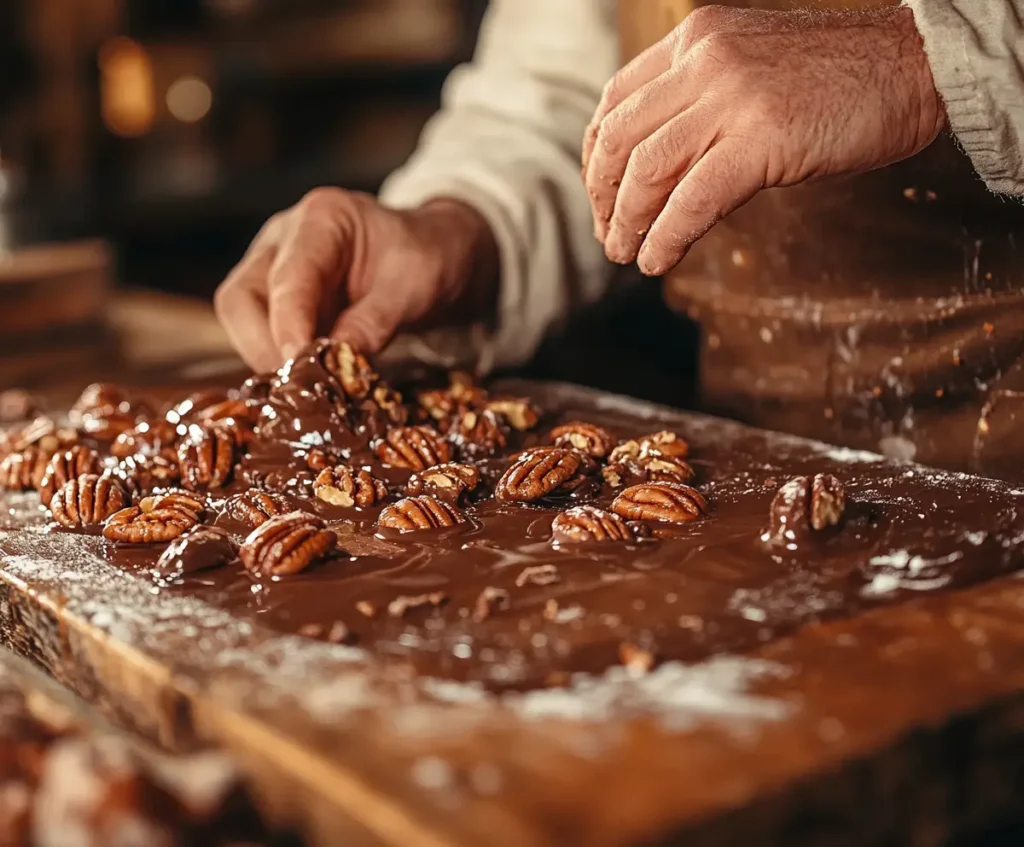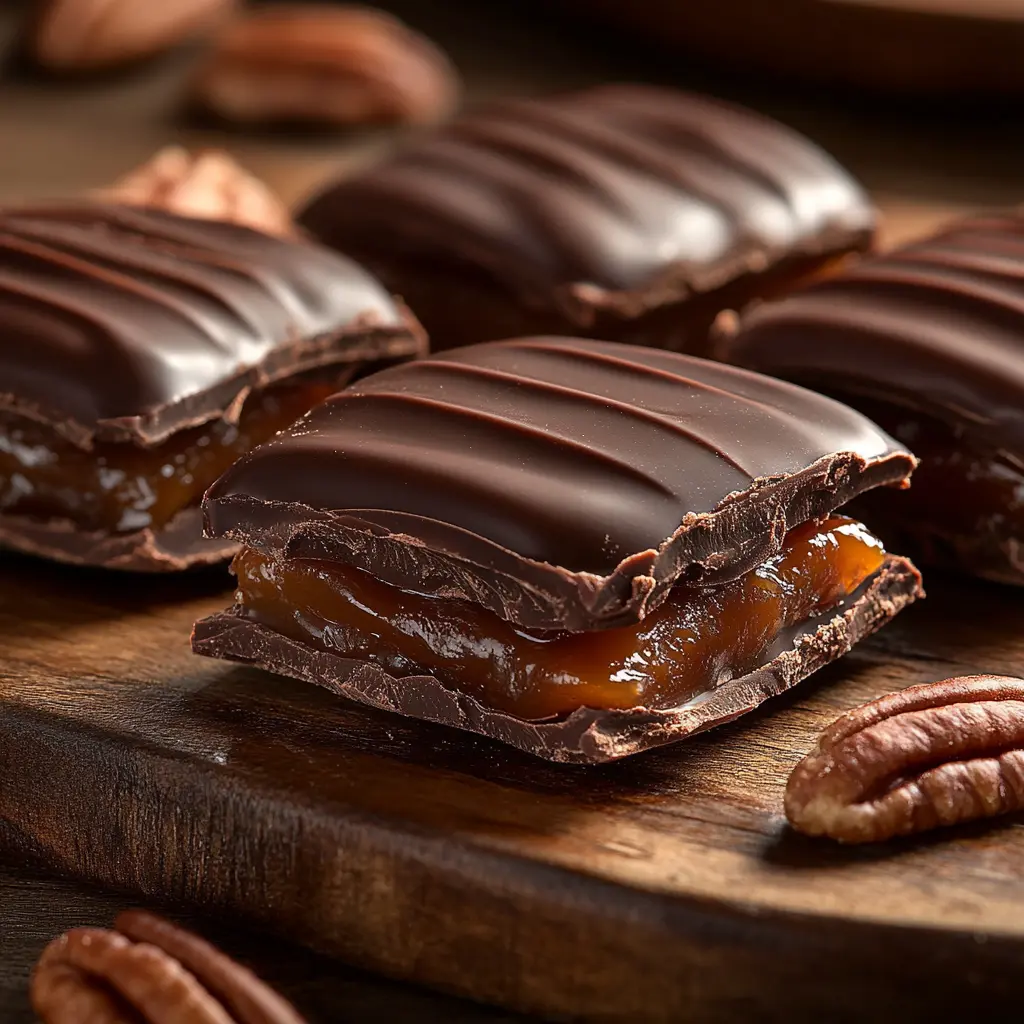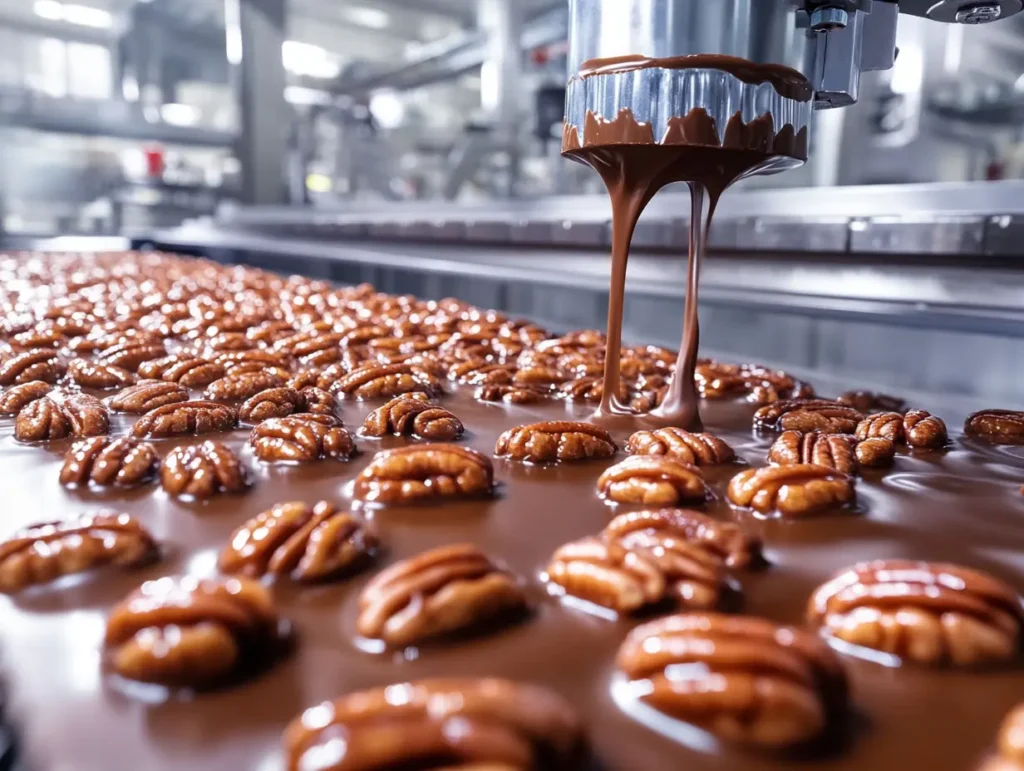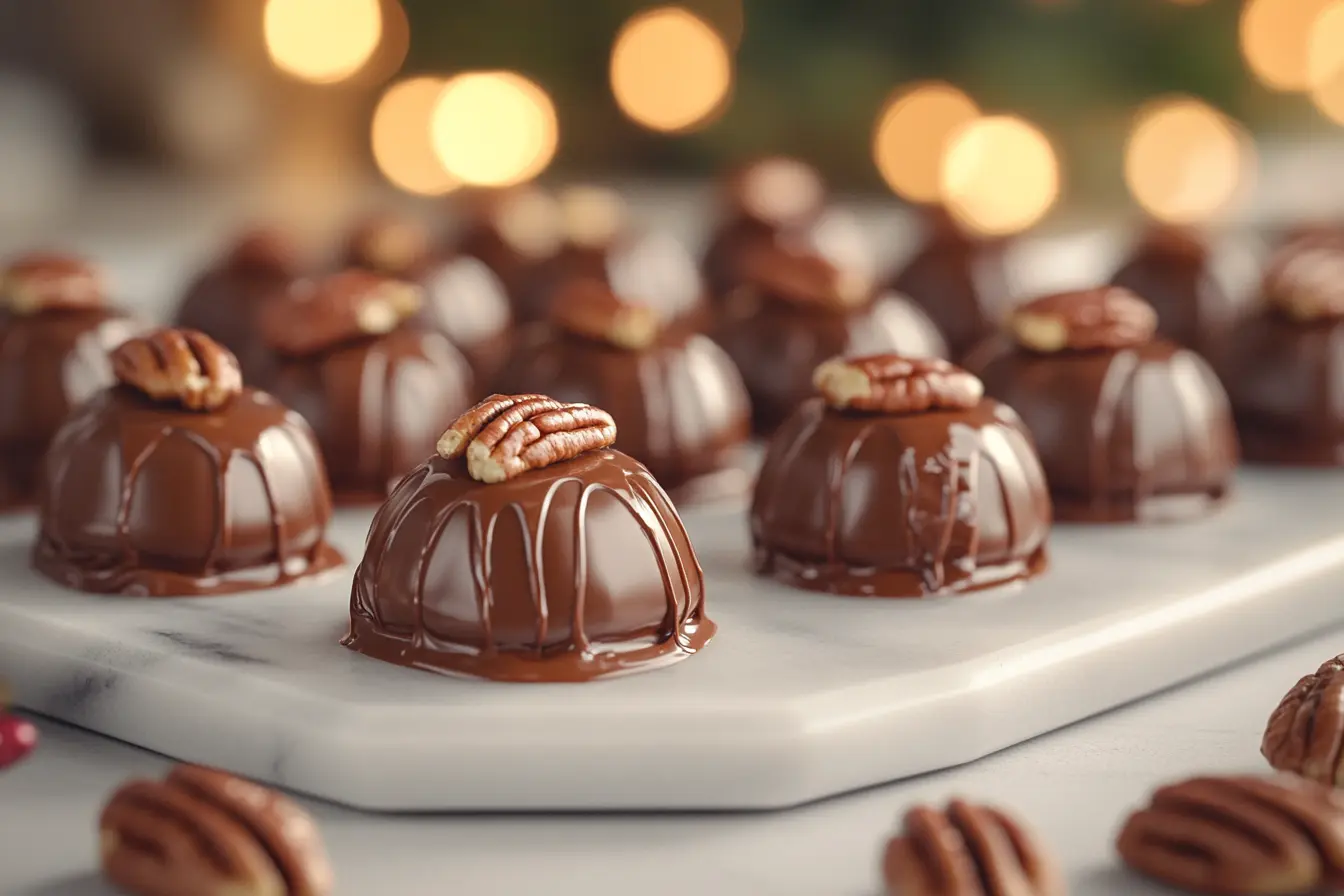Chocolate turtles have been a staple in the world of sweets for over a century. These delightful treats, made with pecans, caramel, and chocolate, have captured the hearts of candy lovers worldwide. But have you ever stopped to wonder why these candies are named after turtles? This article dives deep into their origins, ingredients, and cultural impact, uncovering the story behind the unique name. From their quirky shape to their place in confectionery history, we’ll answer every question you have about chocolate turtles. Let’s begin!
Overview of Chocolate Turtles
Chocolate turtles are a beloved confection known for their distinct turtle-like appearance, made by combining pecans, gooey caramel, and rich chocolate. The resulting treat is not just delicious but also iconic in its design. They are enjoyed as a snack, a dessert, or even as a gift during holidays.
Definition and Description
At their core, chocolate turtles are candies made from a simple trio of ingredients—pecans that form the base or “legs,” caramel for the “body,” and chocolate to coat everything. This combination creates a perfect balance of nutty crunch, chewy sweetness, and creamy richness.
Popularity and Cultural Significance
From small-town bakeries to large-scale manufacturers, chocolate turtles have maintained their place in the confectionery world. They’re a favorite during festive occasions like Christmas and Valentine’s Day and often evoke feelings of nostalgia. With their unique name and design, these candies also stand out in a sea of other sweets.
For an in-depth look at the history, recipes, and creative variations of chocolate turtles, check out our comprehensive guide to chocolate turtles.
Origin of Chocolate Turtles
Creation by Johnson’s Candy Company in 1918
The origins of chocolate turtles can be traced back to 1918 when a creative candy maker at Johnson’s Candy Company in Ohio experimented with a new combination of ingredients. The story goes that the idea was born out of a simple desire to pair pecans with caramel, a popular candy trend at the time. To make the treat even more indulgent, they coated the caramel-pecan mixture with a thick layer of milk chocolate.
This handmade candy quickly became a favorite among locals. The original turtles were handcrafted, with candy makers carefully arranging the pecans to mimic the legs of a turtle, while the caramel and chocolate formed the shell. Though this process was labor-intensive, it gave the candy a unique charm that resonated with customers. By 1918, the candies were well on their way to becoming a signature product of the company, laying the groundwork for their future success.

Evolution and Trademark by DeMet’s Candy Company
By the mid-1920s, DeMet’s Candy Company acquired the rights to produce and sell chocolate turtles. They saw the candy’s potential and trademarked the name “Turtles” to secure its association with their brand. With the rise of automated manufacturing, DeMet’s refined the production process, making it more efficient while preserving the original recipe’s integrity.
DeMet’s took these handcrafted delights and scaled up production to meet increasing demand across the United States. Their marketing campaigns highlighted the playful shape and the indulgent taste of the candy, making “Turtles” a household name. Over time, this trademark became synonymous with quality and tradition, and DeMet’s ensured that every turtle-shaped candy retained the essence of the original creation.
Naming of Chocolate Turtles
Resemblance to Turtle Shape
The name “turtles” wasn’t a random choice—it perfectly describes the candy’s appearance. When the pecans are laid out as the base and topped with caramel and chocolate, they resemble a turtle’s body and legs. The uneven yet charming shape made these candies visually distinct from other confections at the time.
This resemblance wasn’t intentional in the beginning but became a defining characteristic of the candy. The “shell” of chocolate covering the gooey caramel mirrors a turtle’s protective armor, while the pecans jutting out give the illusion of legs peeking from underneath. The playful appearance added to the candy’s appeal, making it not only a treat for the taste buds but also a visual delight.
Anecdote of the Candy Dipper’s Observation
The story behind the name is tied to an anecdote from Johnson’s Candy Company. As the candy dippers were arranging the pecans and drizzling caramel over them, one of the workers remarked that the candy looked like a turtle. The observation stuck, and soon the team began referring to the sweet as “turtles” during production.
This lighthearted moment turned into a branding opportunity. The name was catchy, relatable, and perfectly described the candy’s design. DeMet’s Candy Company later formalized this by trademarking “Turtles” when they took over production, cementing the connection between the candy’s shape and its name.
Key Ingredients
Pecans
The backbone of chocolate turtle candy lies in the pecans, which serve as the “legs” of this iconic treat. Pecans, known for their buttery texture and slightly sweet, nutty flavor, complement the richness of caramel and chocolate perfectly. They also pack a nutritional punch, offering healthy fats, antioxidants, and essential vitamins. According to Healthline, pecans are an excellent source of fiber and may promote heart health, making them a delicious yet wholesome ingredient.
Whether roasted or raw, the pecans’ role in chocolate turtles goes beyond taste—they give the candy its signature appearance, mimicking a turtle’s limbs when arranged in clusters.
Caramel
Caramel forms the chewy center of chocolate turtles, tying together the pecans and chocolate coating. Made by slowly heating sugar, butter, and cream, caramel adds a rich, gooey layer that contrasts with the crunch of the pecans.
The caramel’s golden color and soft texture make it an irresistible part of the candy’s composition. While traditional recipes stick to classic caramel, some variations experiment with flavors like salted caramel, which enhances the candy’s overall taste. Its ability to bind the ingredients together makes it indispensable in creating the iconic “shell” of the turtle.
Chocolate Coating
The final layer of chocolate turtles is the luscious chocolate coating that encases the pecans and caramel. Milk chocolate is the most common choice, offering a creamy and sweet flavor that pairs seamlessly with the other ingredients.
Some modern versions use dark or white chocolate for a twist, but the classic milk chocolate remains a fan favorite. A glossy finish not only adds visual appeal but also ensures the candy is easy to handle without melting too quickly.
Key Ingredients in Chocolate Turtle Candy
| Ingredient | Role in the Candy | Flavor Contribution |
|---|---|---|
| Pecans | Forms the base and adds crunch | Buttery, nutty, slightly sweet |
| Caramel | Acts as a binder and adds chewiness | Sweet, creamy, with a slight burnt sugar note |
| Milk Chocolate | Coats the candy and ties the flavors together | Sweet, smooth, and creamy |
| Dark Chocolate | Alternative coating for a richer flavor | Intense, slightly bitter |
| White Chocolate | Alternative coating for added sweetness | Sweet, with hints of vanilla |

Traditional Preparation Methods
Original Hand-Dipped Techniques
The earliest chocolate turtles were made using hand-dipping techniques, requiring meticulous craftsmanship. Candy makers would carefully lay out pecans on a flat surface, forming the base. Then, a generous dollop of freshly made caramel would be spooned over the pecans, acting as a binder. Once the caramel had set slightly, the candies were dipped into molten chocolate by hand, ensuring an even coating.
This hands-on process allowed artisans to control the shape and texture of each candy, giving them a unique, homemade charm. While this method was time-intensive, it highlighted the care and artistry involved in creating chocolate turtles. Small batches ensured quality, and each candy had its own character, which added to their appeal.
Modern Manufacturing Processes
With the rise of mass production, the preparation of chocolate turtles transitioned to automated systems. Today, machines perform tasks like pecan placement, caramel pouring, and chocolate coating, speeding up the process while maintaining consistency.
The use of conveyor belts ensures that each candy is assembled with precision. Innovations in chocolate tempering technology also help achieve a glossy, durable coating that’s resistant to melting. While modern methods have scaled up production, many companies strive to preserve the traditional flavor and texture of the original hand-dipped candies.
Both techniques—traditional and modern—highlight the enduring popularity of this classic treat. Whether handmade or machine-produced, chocolate turtles continue to delight candy lovers worldwide.

Regional Variations
Canadian Market and Nestlé’s Version
In Canada, chocolate turtles have a particularly strong presence thanks to Nestlé, which produces its own version of the classic treat. Nestlé Turtles, as they are branded, have become a household name in Canadian markets, often associated with special occasions like Christmas and Valentine’s Day.
Nestlé has mastered marketing this iconic candy, packaging it in festive boxes and offering limited-edition flavors to appeal to Canadian consumers. The brand’s adherence to the traditional mix of pecans, caramel, and chocolate ensures that their product stays true to the original recipe while maintaining a distinct identity. Nestlé’s reach has helped cement turtles as a staple treat for celebrations across the country.
Other International Adaptations
Beyond North America, chocolate turtles have inspired similar confections in other parts of the world. In Europe, artisanal chocolate shops often craft turtle-like candies using regional ingredients, such as hazelnuts in Italy or macadamias in Australia.
Meanwhile, in Asia, some variations incorporate local flavors, like green tea-infused caramel or chocolate with hints of yuzu, a citrus fruit. These adaptations cater to local tastes while preserving the basic concept of combining nuts, caramel, and chocolate in a turtle-like shape. The flexibility of the recipe has allowed chocolate turtles to transcend borders, evolving into a globally loved candy.
Flavor and Ingredient Variations
Use of Different Nuts in Chocolate Turtle Candy (e.g., Cashews, Almonds)
While pecans are the hallmark ingredient of chocolate turtle candy, many variations use other nuts to create exciting flavors and textures. Cashews, for instance, add a buttery, creamy richness that pairs seamlessly with caramel and chocolate. Almonds, by contrast, offer a firmer crunch and an earthy undertone that complements the candy’s sweetness.
Walnuts and hazelnuts are also popular substitutes, each bringing their own distinct taste. These alternatives not only allow turtle-shaped chocolate candy to cater to different preferences but also make it more accessible in areas where pecans might not be common. This versatility has made chocolate turtles a favorite treat worldwide, adapting to regional tastes while maintaining their signature charm.
Alternative Chocolate Types for Turtle-Shaped Chocolate Candy (Dark, White)
While milk chocolate is the classic choice for coating turtle-shaped chocolate candy, many modern variations incorporate dark or white chocolate. Dark chocolate introduces a deeper, more robust flavor with a hint of bitterness that contrasts beautifully with the caramel’s sweetness. This option appeals to those who enjoy a less sugary treat.
White chocolate, on the other hand, provides a creamy, vanilla-like sweetness that pairs elegantly with the nuts and caramel. Some variations even combine different types of chocolate—creating marbled designs that are as appealing to the eye as they are to the palate. These innovations in chocolate turtle candy ensure it continues to delight a wide range of tastes while preserving its classic essence.
Chocolate Turtles in Popular Culture
Representation of Turtle-Shaped Chocolate Candy in Media and Literature
Chocolate turtles, also known as turtle-shaped chocolate candy, have become a part of popular culture, symbolizing nostalgia, indulgence, and tradition. Although they may not be as widely recognized as chocolate bars, these candies frequently appear in novels and memoirs that celebrate food and its role in cherished memories. Writers often use chocolate turtle candy as a way to evoke the warmth of family gatherings or simpler times when homemade treats were shared.
In television and film, turtle-shaped chocolate candy is often depicted as a comforting snack, symbolizing affection when characters share them. They’re also highlighted in foodie shows for their unique name and classic combination of ingredients. This blend of familiarity and whimsy ensures that chocolate turtles remain relevant in sweet enthusiasts’ imaginations.
Role of Chocolate Turtle Candy in Festive Traditions and Holidays
Chocolate turtles play a key role in holiday traditions, making them a must-have during Christmas, Valentine’s Day, and Easter. Their luxurious mix of caramel, nuts, and chocolate makes them an ideal gift. Often packaged in elegant, festive boxes, chocolate turtles are celebrated as a premium candy that adds a touch of sweetness to special occasions.
Families often exchange or enjoy chocolate turtle candy during holiday gatherings, enhancing its sentimental value. They’re frequently included in gift baskets or used as stocking stuffers, ensuring their presence in festive celebrations year after year. The combination of their unique name, classic ingredients, and versatility secures their role as both a casual treat and a thoughtful gift.
From their appearances in literature to their place in festive traditions, chocolate turtles are a candy rich in history and cultural significance.
Economic Significance
Market Presence and Sales Figures
The enduring popularity of chocolate turtles has cemented their status as a significant player in the confectionery market. Brands like DeMet’s and Nestlé generate millions in annual sales from these iconic candies, with a steady demand that peaks during holiday seasons.
Turtles are often sold in various formats—from individual packs to large gift boxes—making them accessible to a wide range of consumers. Their consistent presence in grocery stores, specialty shops, and online marketplaces further highlights their importance to the candy industry. Seasonal sales promotions and limited-edition flavors have only added to their financial success, ensuring that turtles remain a profitable product.
Impact on Confectionery Industry
Chocolate turtles have influenced the confectionery industry by inspiring similar candies and innovations. Their simple yet effective combination of ingredients has set a standard for nut-based confections, encouraging other brands to explore creative variations.
The trademarked name “Turtles” has also paved the way for branding strategies that capitalize on quirky, memorable names tied to the product’s appearance. Furthermore, the popularity of chocolate turtles underscores the market’s demand for premium candies that balance nostalgia with indulgence. Their success demonstrates the lasting appeal of traditional recipes in a market often dominated by modern trends.
Frequently Asked Questions
What does turtle chocolate taste like?
Turtle chocolates offer a delightful combination of flavors and textures. They are sweet and nutty, with the buttery crunch of pecans complementing the creamy caramel and rich, smooth chocolate coating. The taste is balanced, with each bite providing a perfect blend of salty, sweet, and nutty notes. Want to know exactly what turtle chocolate tastes like? Check out this complete turtle chocolate flavor guide to learn more about its rich and irresistible profile.
How to make chocolate turtles?
Making chocolate turtles at home is simple. Arrange pecans on a lined baking sheet, drizzle warm caramel over them, and let it set. Then, cover the caramel-pecan clusters with melted chocolate, ensuring they’re fully coated. Once the chocolate hardens, your homemade turtles are ready to enjoy. If you’re looking for a detailed, beginner-friendly tutorial on how to make chocolate turtles at home, check out this step-by-step chocolate turtle recipe.
What are in turtle chocolates?
Turtle chocolates traditionally contain three key ingredients: pecans, caramel, and chocolate. These simple components combine to create a candy that’s crunchy, chewy, and sweet, making it a favorite among candy lovers.
What is a turtle chocolate candy?
A turtle chocolate candy is a confection named for its resemblance to a turtle. It consists of a base of pecans, topped with caramel, and coated with chocolate, mimicking the shape of a turtle with its shell and protruding limbs. To learn more about what a turtle chocolate candy is, its history, ingredients, and some fun facts, check out this detailed guide on turtle chocolate candy.
How do you make homemade chocolate turtles?
To make homemade chocolate turtles, arrange clusters of pecans on a baking sheet, spoon caramel over them, and let it cool. Then, dip or drizzle melted chocolate over the clusters. Refrigerate until firm, and your turtles are ready to share or gift!
Are chocolate turtles gluten-free?
Yes, most chocolate turtles are gluten-free, as they are made with simple ingredients like pecans, caramel, and chocolate. However, always check packaging or recipes to ensure no gluten-containing additives are used.
How to make chocolate caramel turtles?
To make chocolate caramel turtles, first toast the pecans and carefully arrange them on a tray. Then, drizzle the warm, melted caramel over the pecans, ensuring each cluster is evenly coated, and let it cool completely. After that, coat the caramel-pecan clusters with smooth, melted chocolate, making sure to cover them thoroughly. Finally, allow them to set until firm, and there you have it—chewy, nutty treats ready to enjoy!
Conclusion
Chocolate turtles are more than just a candy—they are a delightful blend of taste, tradition, and nostalgia. With their unique name inspired by their turtle-like shape, these treats have become a symbol of indulgence and joy for generations. From their humble beginnings in 1918 to their status as a beloved confection today, chocolate turtles have carved out a special place in the world of sweets.
Whether enjoyed during the holidays, gifted to a loved one, or savored as an everyday treat, chocolate turtles bring people together with their irresistible combination of pecans, caramel, and chocolate. Their versatility in flavor and preparation ensures they remain a timeless favorite, loved by candy enthusiasts worldwide.
The next time you bite into a chocolate turtle, take a moment to appreciate the history, craftsmanship, and deliciousness packed into this iconic treat. It’s not just candy—it’s a celebration of creativity and tradition, all wrapped up in a turtle-shaped delight!

